Hydroponics is a soil-less plant cultivation method, gaining popularity due to its efficient resource use and higher yields. In this technique, plants grow in nutrient-rich water solutions, reducing water usage by up to 90% compared to traditional soil-based farming. Grow lights in hydroponic setups mimic natural sunlight for photosynthesis.
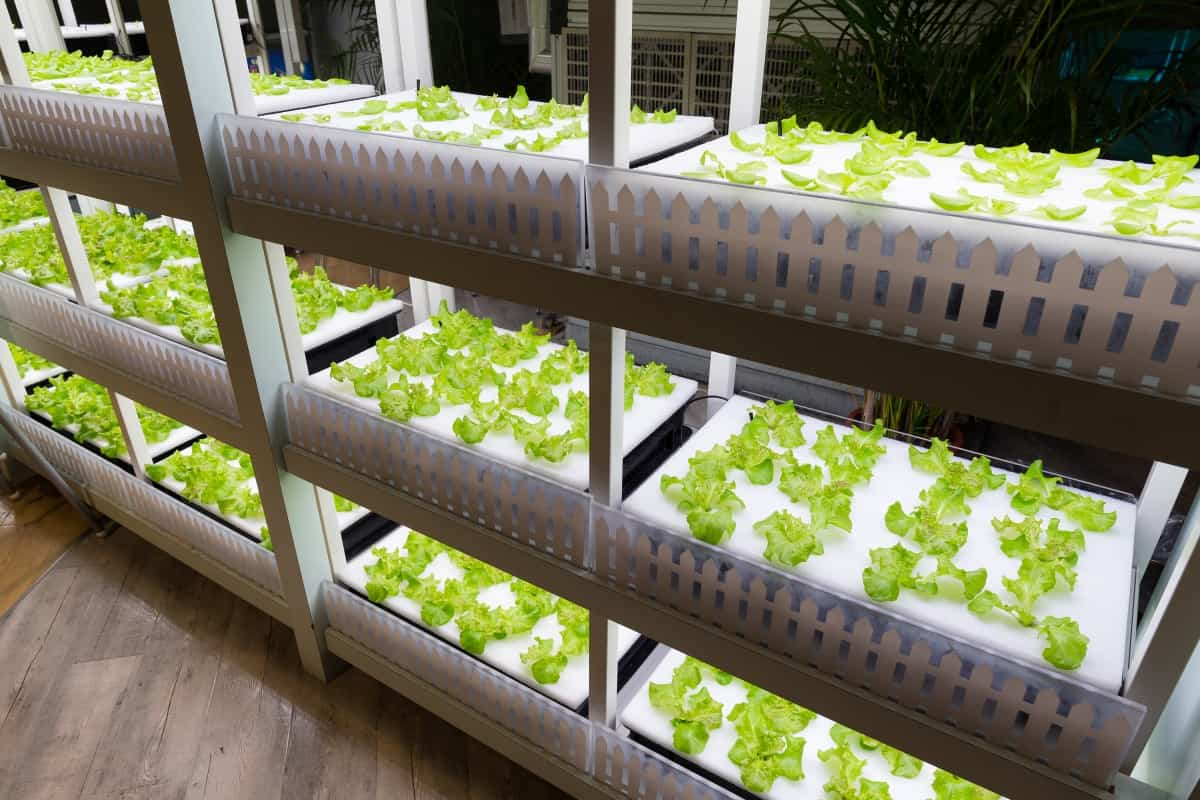
LED grow lights are preferred for their energy efficiency and adjustable light spectrum. This precise light control enhances plant growth and ensures optimal conditions year-round. Let’s check the best plants to grow under grow lights in hydroponics below.
Understanding the Benefits of Hydroponic Gardening
- Water Efficiency: Hydroponic gardening uses up to 85-90% less water than traditional soil-based gardening. The water used is recycled within the system, reducing waste.
- Faster Growth: Plants in hydroponic systems grow 22-50% faster than in soil due to direct access to nutrients and controlled environmental conditions.
- Space Utilization: Hydroponics requires less space as plants can be grown vertically, making it ideal for urban environments and small areas.
- No Soil Issues: Since hydroponics doesn’t use soil, there are no problems with soil-borne diseases, pests, or weeds.
- Nutrient Control: Growers have precise control over nutrient levels, ensuring plants receive the right amount for optimal growth, leading to healthier produce.
- Year-round Cultivation: Hydroponic systems can be set up indoors, enabling year-round cultivation regardless of external weather conditions.
- Higher Yields: Improved growth conditions and consistent nutrient delivery produce higher crop yields than traditional gardening.
- Environmental Impact: Reduced water usage, minimal pesticide requirements, and decreased land usage contribute to a smaller environmental footprint.
Factors to Consider When Choosing Plants for Hydroponics
- Plant Compatibility: Opt for plants that suit hydroponic environments. Leafy greens like lettuce and herbs such as basil and strawberries are well-suited. Assess factors like growth rate and root structure to ensure a good fit.
- Light Requirements: Consider light needs. Leafy plants generally require less light than fruiting ones. LEDs are popular as their energy efficiency and adjustable spectra. Aim for a light intensity of 20,000 to 40,000 lux for most plants.
- Nutrient Demand: Understand the nutrients your chosen plants need. N-P-K ratios (Nitrogen, Phosphorous, Potassium) vary. Microgreens necessitate higher levels of nutrients compared to mature plants.
- Space and Layout: Plan your hydroponic system based on plant sizes. Vine crops like tomatoes need vertical space, while compact herbs can thrive in smaller areas. A well-organized layout optimizes light and nutrient distribution.
- Climate Control: Hydroponic setups are sensitive to temperature and humidity. Aim for 70-75°F (21-24°C) temperature and 50-60% humidity range for diverse crops.
In case you missed it: Growing Vegetables Under Lights: Indoor, Led Lights, Artificial Lights For Beginners
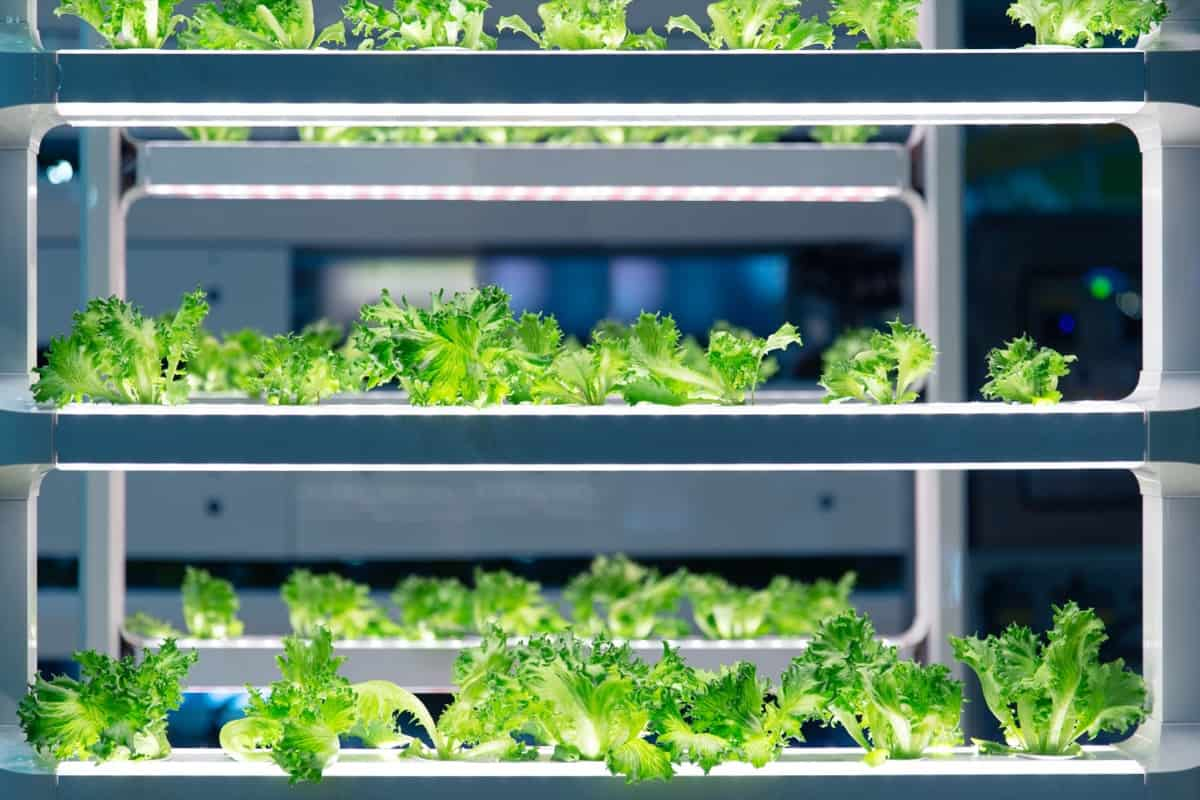
The Importance of Grow Lights in Hydroponic Systems
- Grow lights provide essential light wavelengths for photosynthesis, boosting plant growth and yield in hydroponic setups.
- With grow lights, hydroponic systems can operate independently of natural sunlight, enabling consistent crop production regardless of seasonal changes.
- Tailored light spectrum and intensity ensure optimal plant development, from seedlings to maturity, resulting in healthier and more vigorous plants.
- Hydroponic plants under grow lights exhibit accelerated growth rates, enabling quicker harvest cycles and increased overall productivity.
- Vertical hydroponic systems combined with grow lights maximize space utilization, allowing for higher plant densities and greater output in limited areas.
- Even light distribution from grow lights minimizes uneven growth patterns, leading to uniform crop quality and appearance.
Best Plants to Grow Under Grow Lights in Hydroponics: Leafy Greens
Lettuce, Spinach, Kale, Swiss chard, and Arugula are all suitable for hydroponic systems. Lettuce thrives under blue spectrum lights, with optimal growth occurring under 14-16 hours of light daily. Spinach prefers cooler temperatures and can be placed under full spectrum lights for 10-12 hours daily. Rich in nutrients, Kale thrives under a mix of blue and red spectrum lights for 12-14 hours daily. Swiss chard requires a balanced light spectrum for 12-14 hours daily. Arugula, a fast-growing leafy green, needs around 12 hours of light daily.
In case you missed it: Weed Management in Garlic Farming: How to Control With Organic, Cultural, and Mechanical Methods
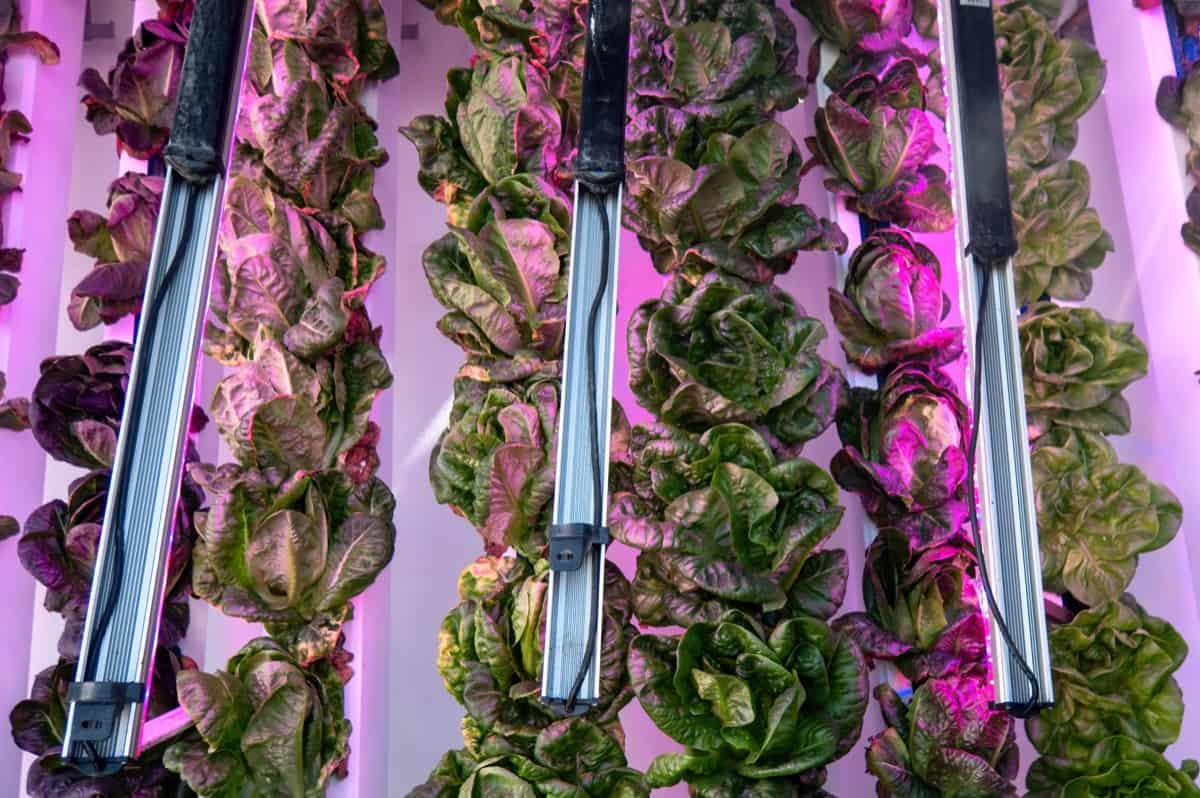
Low-maintenance Plants for Beginner Hydroponic Gardeners
Beginners in hydroponic gardening can find a variety of easy-to-grow plants, including lettuce, basil, Mint, chives, Spinach, strawberries, or Oregano. Lettuce thrives in hydroponics due to its rapid growth and shallow root system, making it ideal for various setups. Basil, an aromatic herb, adapts well to hydroponic environments with proper light and nutrient management. With its hardiness and resilience, Mint is a rewarding addition to hydroponic gardens.
Chives are low-maintenance and forgiving, with their mild onion flavor enhancing various dishes. With its straightforward care requirements and rapid growth, Spinach suits beginners. Strawberry cultivation is achievable for novices, with compact varieties like Alpine strawberries suitable for small spaces. With its robust nature and minimal intervention, Oregano is suitable for hydroponics. Cilantro, with its continuous supply of fresh leaves, offers varied flavors.
Top Choices for Hydroponic Herbs Under Grow Lights
Basil, Mint, parsley, cilantro, chives, and Oregano are some of the top hydroponic herbs under grow lights. Basil is a popular culinary herb with vibrant green leaves rich in flavor and essential oils. Mint, known for its refreshing aroma, thrives in hydroponic setups with grow lights, yielding abundant aromatic leaves for beverages, desserts, and culinary dishes.
In case you missed it: Management of Hydroponic Pests and Diseases: Control, Prevention, and Treatment
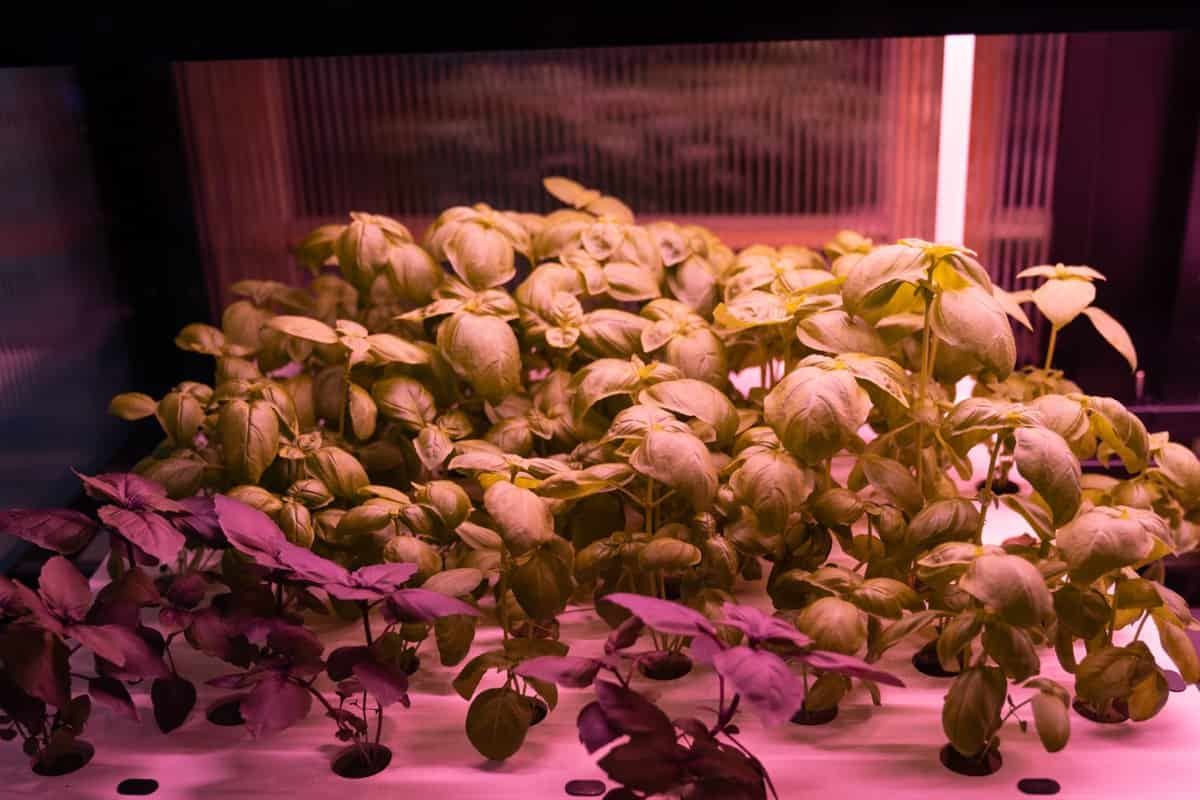
Parsley, preferring cooler temperatures, develops deep green, curly leaves packed with vitamins and minerals. Cilantro, a coriander seed plant, thrives in hydroponic systems with grow lights, producing flavorful leaves and coriander seeds. Chives, onion-flavored leaves, are valuable to hydroponic gardens under grow lights, yielding long, flavorful leaves that enhance various dishes. Oregano, a compact growth habit suitable for controlled environments, develops intense flavor and aroma when exposed to appropriate light levels.
Nutrient-dense Vegetables Suitable for Hydroponic Cultivation
- Spinach (Spinacia oleracea): Packed with vitamins A, C, K, and folate, Spinach offers a nutrient bonanza. Its tender leaves thrive in hydroponic systems, providing a continuous harvest.
- Kale (Brassica oleracea var. acephala): A powerhouse of antioxidants and vitamins, Kale excels in hydroponics. Its curly or flat leaves offer diverse culinary uses and consistent growth.
- Swiss Chard (Beta vulgaris var. cicla): These vibrant green leaves and colorful stems contain vitamins, minerals, and fiber. Hydroponic Swiss chard is easy to cultivate and adds visual appeal.
- Lettuce (Lactuca sativa): With numerous varieties like butterhead and romaine, lettuce adapts well to hydroponic setups, offering a continuous supply of crispy, nutrient-rich leaves.
- Watercress (Nasturtium officinale): Hydroponic watercress yields peppery, vitamin-packed greens that elevate salads and dishes while also being an excellent source of calcium.
Fruiting Plants Ideal for Hydroponics and Grow Lights
Hydroponic systems under grow lights offer efficient cultivation with controlled conditions for optimal yields. Some prime fruit plants that thrive in such setups include strawberries, tomatoes, peppers, cucumbers, blueberries, melons, citrus trees, and figs. Strawberries thrive in LED grow lights, yielding sweet and juicy berries year-round. Tomatoes exhibit accelerated growth and abundant fruiting, providing flavorful and nutrient-rich harvests. Peppers respond well to hydroponic environments with grow lights, producing vibrant peppers with controlled nutrient intake.
Cucumber cultivation with proper lighting fosters consistent and crisp production. Blueberries yield antioxidant-rich fruits with careful pH and nutrient management. Melons thrive in hydroponics under intense light, yielding sweet and succulent fruits with attentive care. Dwarf citrus trees can be grown hydroponically with specialized lighting, providing fresh indoor fruits. Fig trees can bear flavorful fruits in controlled environments with meticulous hydroponic care and appropriate light exposure.
Fast-growing Plants for Quick Harvests in Hydroponics
Spinach: A hydroponic delight, Spinach thrives in moist environments. It reaches harvest size in just 14–20 days from seedling, offering a rapid yield when planted densely. With weekly leaf harvests, a continuous spinach supply can be maintained. Ideal greenhouse temperatures range from 24–30°C (75–85°F), avoiding frost-sensitive growth below ten °C (50°F). Harvesting outer leaves while allowing inner ones to flourish is recommended. Spinach is a zinc-rich option and grows remarkably fast.
Swiss Chard: Renowned for speed, Swiss chard flourishes hydroponically, surviving within the pH 6.2–7 range. Ready to harvest in approximately 35 days, it continues yielding after harvest. Adaptable to varied temperatures, it thrives in cooler climates (10–30°C), withstanding light frost. Sow seeds 1/2–1 inch deep, 3–6 inches apart, managing multiple shoots from seeds. Full sun-loving Swiss chard seeds can be stored for up to five years, offering easy replanting. Notable for high vitamin K content.
Mint and Spearmint: Mint is an enthusiastic hydroponic grower, especially when transplanted as a young plant. Its rapid expansion adds minty freshness to dishes. While germination from seeds requires patience, established nursery plants accelerate growth. Minimal care and ample water lead to a thriving Mint.
Flowering Plants That Thrive in Hydroponic Environments with Grow Lights
Hydroponics with grow lights is popular for flowering plants, including roses, orchids, carnations, African violets, snapdragons, petunias, Gerbera daisies, and chrysanthemums. Roses thrive in controlled lighting, displaying vibrant blooms and extended longevity. Orchids, known for their elegance, yield vivid blossoms. Carnations thrive in hydroponic systems with optimized light conditions, resulting in fragrant and enduring blooms.
In case you missed it: Ways to Use Neem Oil in Plants: Benefits in Agriculture, Application Method in Garden, and Uses in Hydroponics
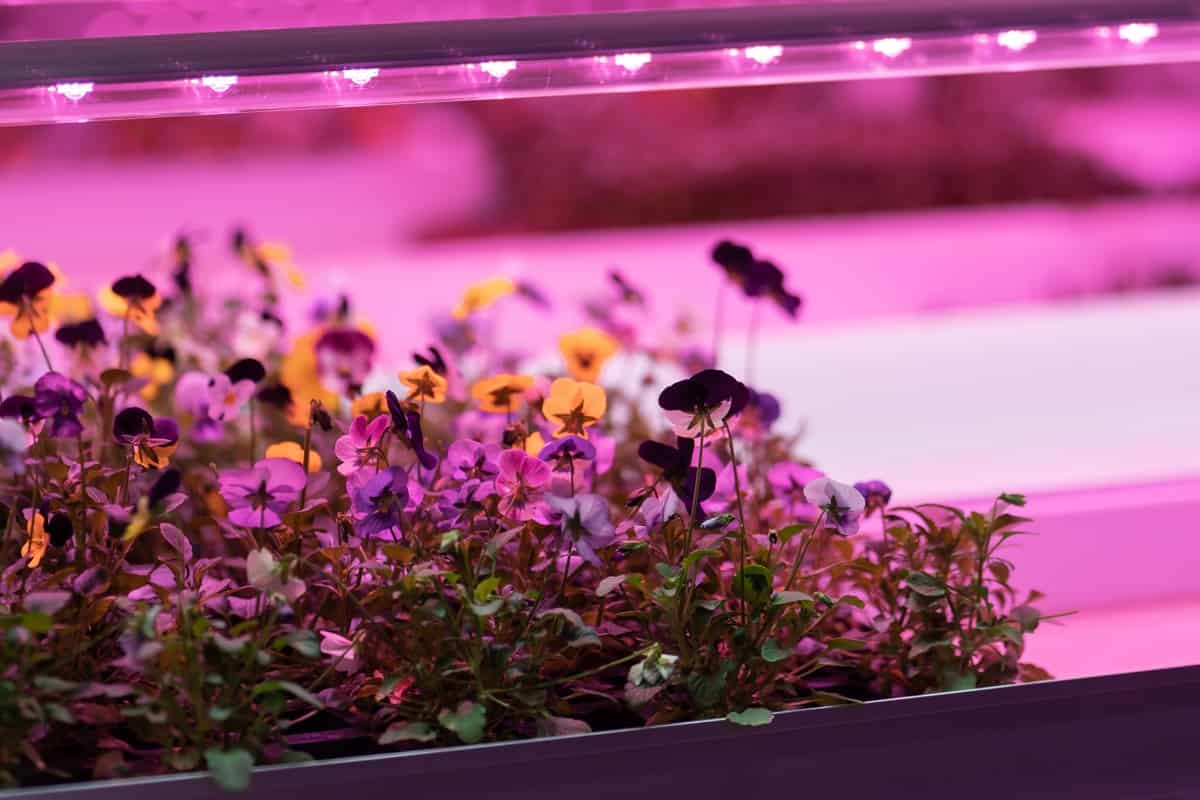
African violets offer a variety of colors and unique petal formations. Snapdragons showcase their vibrant blossoms, while petunias promote lush and abundant flowers in various hues. Gerbera daisies produce colorful flowers that add vibrancy to indoor spaces. Chrysanthemums create dense and captivating blooms in various shapes and colors.
Dwarf Varieties and Compact Plants for Limited Space Hydroponics
Compact plant varieties are ideal for space-conscious hydroponics, offering abundant yields without overwhelming the area. These plants are optimized for constrained environments, making them perfect for indoor gardening and small setups. Examples include Tiny Tim Tomato, Mini Bell Peppers, Babyleaf Lettuce, Mini Cucumbers, Micro Herbs, Dwarf Beans, Miniature Eggplants, and Compact Strawberries.
Tiny Tim Tomato produces cherry-sized fruits, Mini Bell Peppers thrive in limited spaces, Babyleaf Lettuce provides fresh leaves in minimal space, Mini Cucumbers yield crisp, mini-sized fruits, Micro Herbs like basil, cilantro, and parsley are available in compact versions, Dwarf Beans offer generous pods on a small footprint, and Miniature Eggplants deliver the unique taste of eggplant without bulk. These compact plant options align perfectly with space-saving hydroponic systems, maximizing yield while minimizing space requirements.
Unique and Exotic Plants to Cultivate in a Hydroponic System with Grow Lights
Hydroponics offers way to grow plants, such as dragon fruit, wasabi, saffron, Venus flytraps, pitcher plants, vanilla orchids, moringa, and cacao. These plants thrive under proper lighting, producing vibrant fruits, fresh, spicy roots, and the world’s costliest spice. They also require precise nutrient and light management, allowing them to thrive in controlled environments. Additionally, hydroponic moringa cultivation offers nutrient-rich leaves and pods known for their health benefits. Small-scale cacao cultivation with hydroponics provides an opportunity to grow chocolate-producing trees indoors.
The Role of Grow Lights in Hydroponics and Plant Selection
- Grow Lights for Specific Plants: Not every plant requires a grow light. Choosing the right one is vital, considering plant type and budget. Different lights emit varying amounts of heat, so heat-sensitive plants demand cooler options.
- Intensity Matters: Grow light intensity should match plant needs. Bright lights might overwhelm delicate plants, necessitating lower-intensity options.
- Wavelength Consideration: Light wavelengths influence plant growth. Blue light aids leaf growth, while red light promotes flowering. Picking the right wavelength is crucial.
- Ideal Hydroponic Plants: Certain plants excel in hydroponics under grow lights. Notable options include lettuce, Spinach, Kale, Swiss chard, arugula, basil, cilantro, watercress, tomatoes, cucumbers, peppers, and eggplants.
- Growing Tips: Optimal grow light size, distance (12-18 inches), proper watering (avoid over-watering), regular fertilization, and pest/disease vigilance ensure successful hydroponic growth.
- Advantages of Grow Lights: Plants under grow lights thrive due to controlled light spectrum, faster growth, reduced search for nutrients/water, and minimizing pest/disease risks.
- Space Efficiency: Hydroponic setups with grow lights allow space-efficient cultivation, benefiting those with limited room.
In case you missed it: Management of Greenhouse Pests and Diseases: Management, Control, Prevention, and Treatment
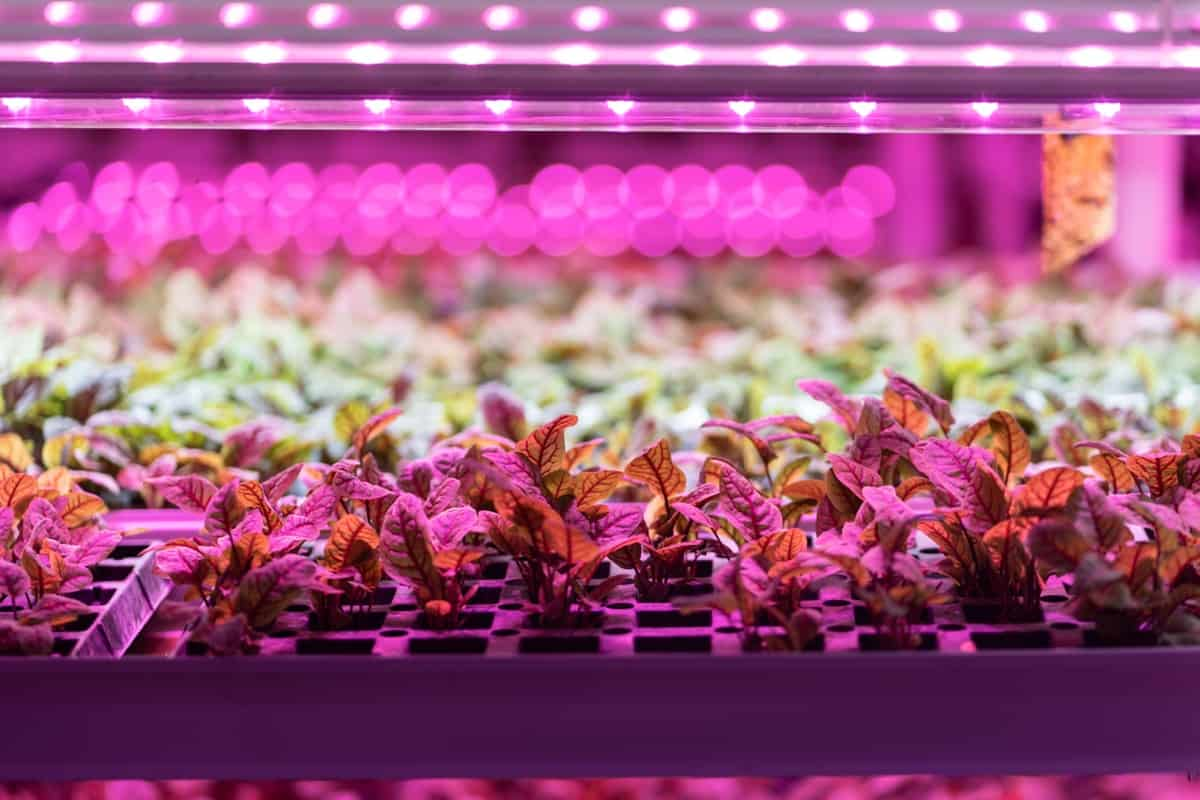
Tips for Successful Plant Growth in Hydroponics with Grow Lights
To optimize growth, choose LED grow lights with a balanced wave spectrum of blue and red wavelengths, which fuel leaf development and stimulate flowering. Maintain a 12-18 inch distance between plants and lights to prevent light burn and ensure adequate coverage. Tailor light exposure to mimic natural daylight hours, aiming for 14-16 hours of light daily and 8-10 hours of darkness.
Monitor grow room temperature to maintain optimal growth, and use a pH meter to monitor nutrient solution acidity. Ensure adequate oxygenation of the nutrient solution using air stones or diffusers to prevent root diseases. Maintain cleanliness to prevent mold, algae, and pests, and regularly sanitize equipment, grow trays, and containers. Monitor nutrient levels and adjust concentrations as plants grow, aiming for an Electrical Conductivity (EC) of 1.2-2.5 for optimal results.
Conclusion
Incorporating hydroponics with grow lights offers optimal conditions for cultivating fast-growing and nutrient-rich plants like lettuce, Spinach, herbs like basil, and cilantro, and compact options such as microgreens. Swift harvests and controlled environments make these choices ideal for indoor gardening success.
- How to Build a Low-budget Goat Shed: Cheap Ideas and Tips
- Goat Farming Training Programs in India: A Beginner’s Guide
- Types of Pesticides Used in Agriculture: A Beginner’s Guide
- Economical Aquaculture: A Guide to Low-Budget Fish Farming
- 15 Common Planting Errors That Can Doom Your Fruit Trees
- How to Make Houseplants Bushy: Effective Tips and Ideas
- Innovative Strategies for Boosting Coconut Pollination and Yield
- Pollination Strategies for Maximum Pumpkin Yield
- The Complete Guide to Chicken Fattening: Strategies for Maximum Growth
- Natural Solutions for Tulip Problems: 100% Effective Remedies for Leaf and Bulb-Related Issues
- Revolutionizing Citrus Preservation: Towards a Healthier, Greener Future
- Natural Solutions for Peony Leaf and Flower Problems: 100% Effective Remedies
- Maximizing Profits with Avocado Contract Farming in India: A Comprehensive Guide
- Natural Solutions for Hydrangea Problems: 100% Effective Remedies for Leaf and Flowers
- The Ultimate Guide to Choosing the Perfect Foliage Friend: Bringing Life Indoors
- From Sunlight to Sustainability: 15 Ways to Use Solar Technology in Agriculture
- The Ultimate Guide to Dong Tao Chicken: Exploring from History to Raising
- The Eco-Friendly Makeover: How to Convert Your Unused Swimming Pool into a Fish Pond
- Mastering the Art of Delaware Chicken Farming: Essentials for Healthy Backyard Flocks
- 20 Best Homemade Fertilizers for Money Plant: DIY Recipes and Application Methods
- How to Craft a Comprehensive Free-Range Chicken Farming Business Plan
- Brighten Your Flock: Raising Easter Egger Chickens for Beauty and Bounty
- How to Optimize Your Poultry Egg Farm Business Plan with These Strategies
- Subsidy for Spirulina Cultivation: How Indian Government Schemes Encouraging Spirulina Farmers
- Ultimate Guide to Raising Dominique Chickens: Breeding, Feeding, Egg-Production, and Care
- Mastering the Art of Raising Jersey Giant Chickens: Care, Feeding, and More
- Ultimate Guide to Raising Legbar Chickens: Breeding, Farming Practices, Diet, Egg-Production
- How to Raise Welsummer Chickens: A Comprehensive Guide for Beginners
- How to Protect Indoor Plants in Winter: A Comprehensive Guide
- Ultimate Guide to Grow Bag Gardening: Tips, Tricks, and Planting Ideas for Urban Gardeners
- Guide to Lotus Cultivation: How to Propagate, Plant, Grow, Care, Cost, and Profit
- Agriculture Drone Subsidy Scheme: Government Kisan Subsidy, License, and How to Apply Online
- Ultimate Guide to Raising Araucana Chickens: Breed Profile, Farming Economics, Diet, and Care
- Bringing Hydroponics to Classroom: Importance, Benefits of Learning for School Students
- Ultimate Guide to Raising Polish Chickens: Breed Profile, Farming Economics, Diet, and Care
- Ultimate Guide to Raising Australorp Chickens: Profile, Farming Economics, Egg Production, Diet, and Care